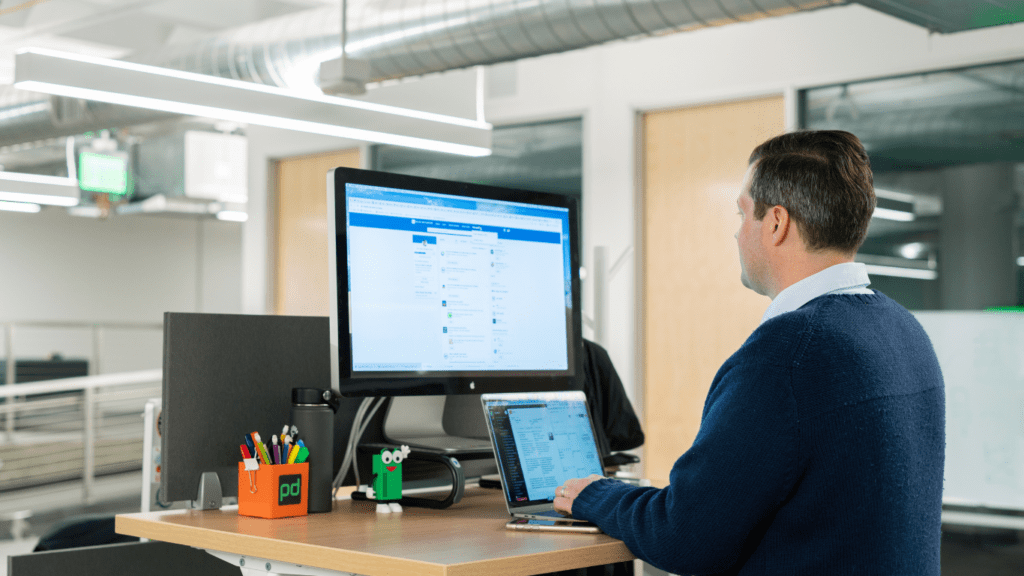Understanding LinkedIn For B2B Lead Generation
LinkedIn serves as a powerful platform for B2B lead generation due to its professional focus. Unlike other social media networks, LinkedIn caters specifically to business professionals, making it an ideal environment for networking, building relationships, and generating high-quality leads.
LinkedIn’s features facilitate targeted outreach effectively. Advanced search filters within LinkedIn Sales Navigator, for example, allow precise targeting based on job titles, industries, company sizes, and specific geographic locations. This advanced targeting ensures that my efforts are concentrated on the most relevant decision-makers.
Another crucial element is LinkedIn Content Marketing. Sharing informative articles, industry news, and engaging multimedia content positions me as a thought leader. When the audience finds my content valuable, engagement levels rise, leading to increased visibility and enhanced credibility.
InMail represents a direct communication channel that bypasses traditional gatekeepers. Since LinkedIn InMail messages can be sent to any user, even without a prior connection, it significantly increases the chances of reaching potential leads directly. Personalizing InMail messages increases the likelihood of a positive response.
Additionally, joining and participating in LinkedIn Groups related to my industry provides opportunities to engage with like-minded professionals. This form of interaction often leads to meaningful connections and valuable insights, further enhancing lead generation efforts.
Lastly, the Analytics and Insights tool on LinkedIn offers valuable data on profile visitors, post engagements, and audience demographics. By analyzing this data, I can refine my strategies to match audience preferences more accurately, improving overall lead quality.
Using LinkedIn for B2B lead generation involves utilizing its features for targeted outreach, engaging content marketing, direct communication, group participation, and data analysis. The platform’s professional focus maximizes the likelihood of connecting with high-quality prospects.
Setting Up An Effective LinkedIn Profile
An optimized LinkedIn profile lays the foundation for successful B2B lead generation. It’ll help attract potential leads and showcase professional expertise.
Creating A Professional Headline
A professional headline captures the essence of your role and value proposition. It should include keywords relevant to your industry. For example, if you’re a SaaS marketer, “B2B SaaS Marketing Specialist Lead Generation Expert” works well. This tells visitors your specialization and attracts searches related to your skills.
Crafting A Compelling Summary
A compelling summary provides a snapshot of your professional journey, achievements, and goals. It should start with a strong statement about your role and its impact. For instance, “I drive growth for B2B SaaS companies through comprehensive marketing strategies.” Use bullet points to list key accomplishments. Ensure keywords are naturally integrated to improve searchability.
Highlighting Your Experience & Skills
Highlight your experience and skills by detailing current and past roles with concrete achievements. Use metrics to demonstrate impact, like, “Increased lead generation by 40% within one year.” Include endorsements for key skills to build credibility. For example, list skills like “Content Marketing,” “CRM Management,” and “Lead Generation Strategies,” and ensure colleagues endorse them.
Building Your LinkedIn Network
Expanding my LinkedIn network has been crucial for effective B2B lead generation. A strong network increases visibility and opens doors to growth opportunities.
Targeting The Right Connections
Connecting with the right people is essential. I prioritize decision-makers in target industries, influencers, and potential partners. I use LinkedIn Sales Navigator to filter prospects based on job title, industry, and company size. By targeting these connections, I ensure my network is relevant and valuable.
Engaging With Your Network
To maintain an active network, I consistently engage with my connections. I comment on their posts, share relevant content, and participate in discussions. Personalized messages help me build stronger relationships. I also send congratulatory notes on milestones to stay top of mind. Engaging actively keeps my network dynamic and opens avenues for potential leads.
Content Strategy For Lead Generation
A robust content strategy on LinkedIn is essential for effective B2B lead generation. By sharing valuable content and leveraging LinkedIn Articles, you can position yourself as a thought leader and attract high-quality leads.
Sharing Valuable Content
- Sharing valuable content regularly engages your LinkedIn network and keeps your presence visible.
- Focus on posting insights, industry news, and actionable tips that resonate with your target audience.
- Use data to back up your recommendations and include real-world examples for clarity.
- Ensure that your posts are visually appealing by incorporating images, infographics, and videos.
- Content with visuals garners 94% more total views, increasing its likelihood of being shared and generating more leads.
- Utilize LinkedIn’s native video feature to share insights in a more personal and engaging manner.
- Engage with your audience by responding to comments and participating in discussions.
- This interaction builds trust and shows potential leads that you value their input.
Leveraging LinkedIn Articles

LinkedIn Articles allow you to showcase your expertise in-depth, providing value beyond short posts. Use them to delve into complex topics, share case studies, and provide comprehensive how-to guides. Ensure that your articles are well-researched and include credible sources.
Optimize your articles for SEO by including relevant keywords throughout the text. Use headings, subheadings, and bullet points to make your content easy to read and searchable.
Promote your articles across your LinkedIn network and encourage others to share them. Higher engagement levels lead to increased visibility on the platform, attracting more potential leads.
Regularly publishing articles establishes you as a thought leader and keeps your profile active. This ongoing activity signals to LinkedIn’s algorithm that your content is relevant and valuable, further enhancing your reach and lead generation efforts.
Utilizing LinkedIn Groups
Utilizing LinkedIn Groups can significantly enhance lead generation efforts. These groups create opportunities to connect with industry peers and potential clients, fostering meaningful interactions and expanding your network.
Finding Relevant Groups
Finding the right LinkedIn Groups is crucial for successful lead generation. I start by searching for keywords relevant to my industry, products, or services. For instance, entering terms like “B2B marketing” or “sales strategy” helps locate groups that align with my business interests. Next, I evaluate the group’s activity level by checking the number of members and the frequency of posts. Groups with active discussions provide better engagement opportunities. Reviewing the group description also ensures it matches my objectives and target audience.
Active Participation Strategies
Active participation in LinkedIn Groups boosts visibility and credibility. I contribute by sharing valuable insights, answering questions, and starting discussions related to my expertise. For example, I might post articles I’ve written or comment on industry news. Consistent activity demonstrates my commitment and knowledge, making it easier to build trust with other members. Additionally, I leverage LinkedIn’s features, such as polls and event announcements, to engage group members more dynamically. Connecting with active participants in the group also helps create a more robust professional network.
LinkedIn Ads For Lead Generation
LinkedIn Ads can play a crucial role in capturing and converting high-quality B2B leads. I’ll explore the potential of Sponsored Content, Text Ads, and Sponsored InMail for effective lead generation.
Sponsored Content
Sponsored Content appears directly in the LinkedIn feed of targeted users, ensuring high visibility. These ads look like regular posts but are labeled as “Sponsored,” making them less intrusive. I use Sponsored Content to share thought leadership articles, case studies, and product updates with key decision-makers.
Sponsored Content helps segment my audience based on criteria like job title, company size, and industry. This ensures precision in targeting, enhancing the chances of lead conversion. For example, promoting a case study about a successful collaboration with a major client helps establish credibility.
Text Ads & Sponsored InMail
Text Ads are simple, cost-effective ads displayed on the sidebar. They consist of a short headline, brief text, and a small image. I use Text Ads to drive traffic to my landing pages, where potential leads can access more information.
Sponsored InMail delivers personalized messages directly to LinkedIn users’ inboxes. It’s akin to email marketing but with LinkedIn’s targeting power. I craft personalized messages that address specific pain points. By targeting users based on their profile information, these messages have a higher open rate.
Measuring & Optimizing Performance
Effectively leveraging LinkedIn for B2B lead generation involves not just implementing strategies but also continuously measuring and optimizing performance. Monitoring critical metrics and conducting A/B tests are essential steps in refining your approach.
Tracking Key Metrics
Tracking key metrics ensures you’re gaining insights from your LinkedIn activities. I focus on several essential metrics to gauge success:
- Engagement Rate: Measures how well your content resonates with your audience. High engagement indicates your posts are relevant and valuable.
- Click-Through Rate (CTR): Tracks the percentage of users who click on your links. A higher CTR means your content compels users to act.
- Conversion Rate: Assesses the proportion of leads generated from your LinkedIn activities. This metric directly correlates with the effectiveness of your lead generation efforts.
- Follower Growth: Monitors the increase in your LinkedIn followers, reflecting your expanded reach and influence.
- InMail Response Rate: Evaluates the effectiveness of your direct outreach efforts through LinkedIn InMail.
A/B Testing & Iteration
A/B testing fine-tunes your LinkedIn strategies by comparing different versions of your content or campaigns. Iteration based on these tests enhances performance. Here’s how I approach A/B testing:
- Content Variations: Test different types of content, such as articles, infographics, and videos, to see which format garners more engagement.
- Headline Testing: Experiment with multiple headlines to determine which attracts more clicks and interactions.
- Audience Segmentation: Create different audience segments for your campaigns and test targeted messages to each group.
- Posting Times: Analyze the impact of posting at various times of the day to find the optimal schedule for maximum visibility.
- Ad Creatives: Evaluate various ad designs, calls-to-action, and messaging to identify what drives higher conversion rates.
By consistently measuring and optimizing performance, I ensure my LinkedIn B2B lead generation efforts are both effective and efficient.



